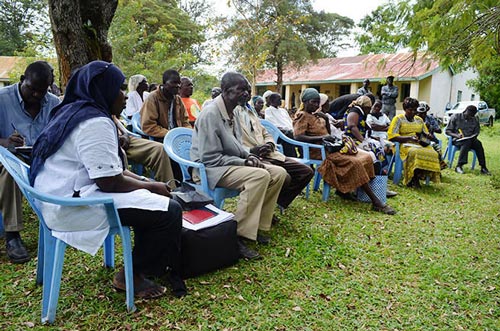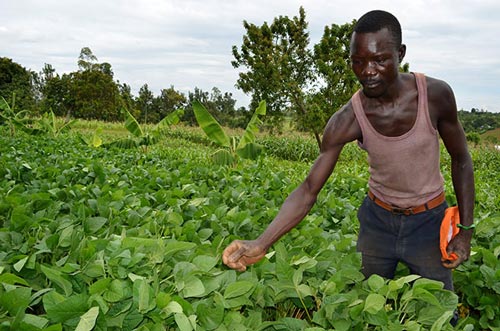By Michael Arunga/CIMMYT
Farmers in Siaya and Bungoma counties of western Kenya, a region with low agricultural productivity, are embracing good agricultural practices and increasing their harvests through innovation platforms established as part of the Sustainable Intensification of Maize-Legume Systems for Food Security in Eastern and Southern Africa (SIMLESA) project, in collaboration with the Kenya Agricultural Research Institute (KARI).

This was evident during 7-8 October when a team of scientists from CIMMYT, KARI, SIMLESA and the International Crops Research Institute for the Semi-Arid Tropics (ICRISAT) visited farmers in both counties who are members of the Boro and Bungoma South farmer innovation platforms. During the visit, farmers described how they had adopted conservation agriculture and intercropping and switched to using herbicides to control weeds.
Ferdinand Makhanu, one of several farmers visited in the Bumula region, said that information from SIMLESA’s innovation platforms has helped him improve his seed and farming technologies. “I initially harvested 10 bags of maize, which increased to 15,” he said. “I attribute this yield increase to utilizing the rich information I got during innovation platform meetings.” Makhanu’s farm is only about half a hectare, so the yield increase he describes — 450 kilograms (each bag of maize weighs about 90 kilograms) — is significant. He stated he now has better harvests, a greater variety of food crops on his farm and healthier cattle, enabling him to provide for the basic needs of his seven children.
About 200 kilometers away, in Siaya County, Julius Ong’ayi from the Ng’ombe Sifa Self Help Group also praised the innovation platforms. “I learned about conservation agriculture, which has improved my soil’s fertility,” he said. Ong’ayi said the greatest challenge faced by area farmers is adapting to new farming methods. “Many farmers stubbornly stick to traditional seeds, when innovation platforms provide modern solutions that improve yields,” he told the visiting SIMLESA team.

An Operational Field Guide for Developing and Managing Local Agricultural Innovation Platforms, produced by KARI with funding from AusAID through the Australian Centre for International Agricultural Research (ACIAR), which also funds SIMLESA, defines an innovation platform as a forum to foster interaction among a group of relevant stakeholders around a shared interest. Innovation platforms offer opportunities or practical solutions at the local level, linking farmers to markets and other stakeholders, and provide evidence for realistic policies and policy areas at the regional and national levels, according to Mulugetta Mekuria, CIMMYT socioeconomist and SIMLESA coordinator.
Mekuria urged farmers to try new maize varieties, including drought-tolerant ones developed in collaboration with CIMMYT and released by KARI. “We know farmers want to use the varieties they know and have used for many years,” Mekuria said. “However, we have farm-level evidence that the new varieties grown under conservation agriculture-based sustainable intensification practices contribute to increased yield, reduce production costs and improve soil fertility over time.”
 Innovations
Innovations